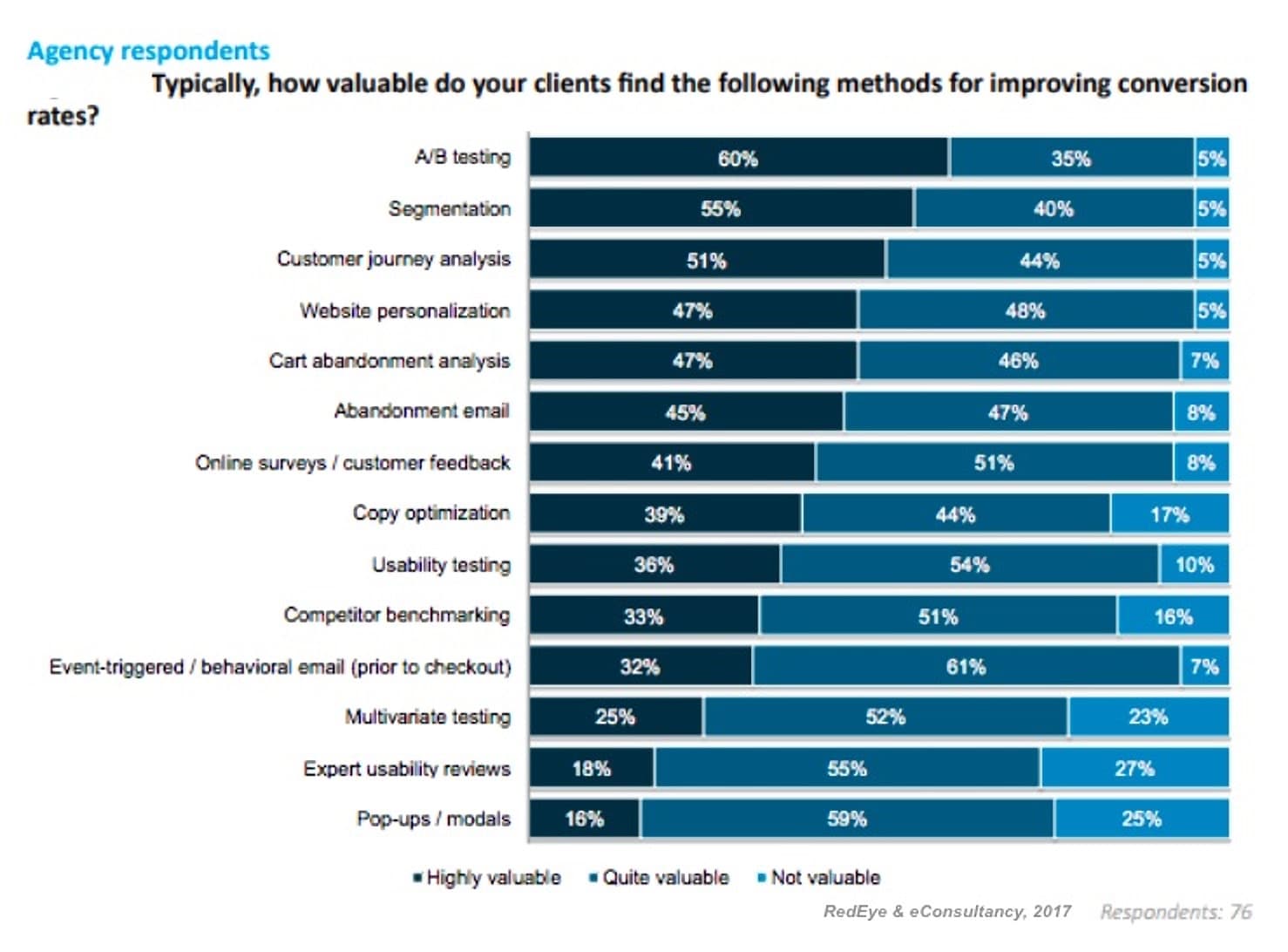Article first published June 2017, updated April 2020
If you’ve been working in marketing for a few years, it’s likely you’ve heard about data-driven marketing.
Data-driven marketing, just like its cousin “growth hacking,” has become a big hit among the marketing community.
Check Google Trends, and you will see how popular it has become in recent years:

Source: Google Trends
Far from being a fad, data-driven marketing is a real thing. Marketers want to learn more about it because it works. For example, according to a study by Statista, 89% of marketers worldwide use data to make their strategic decisions.
So what is data-driven marketing? And how can you use it to deliver better results for your company?
Read on to discover what data-driven marketing is by learning how data and marketing work together, as well as three ways to increase your conversion rate with data-driven marketing.
How data and marketing work together
Online marketing has one large advantage over its offline counterpart: tracking. The development of modern software tools has allowed marketers to track almost anything online.
For example, Google AdWords provides you with the exact number of impressions your ads get, the demographics of your audience, and the specific amount of money each ad generates. Campaign Monitor, on the other hand, shows you the open rates, click-through rates, and the number of clicks each link on your email gets, among other metrics.
The sophistication from which technology companies deliver their data helps marketers understand what works and what doesn’t. This allows companies to get a deep understanding of the results they’re getting for what they spend on each channel, as well as improving the customer experience once people are on their site.
Having access to large amounts of data has both positive and negative implications for marketers. The good news is that having access to data can help marketers optimize their campaigns to maximize results. Just like the old saying goes, “what gets measured gets done,” whatever you can measure, you can improve.
The bad news is: marketers can get flooded with all sorts of irrelevant data, making them lose sight of what matters. Even though you can see how many clicks each email link gets, how do you use that information to impact your strategy?
Data analysis requires discipline and a passion for mining data for insights. You need to know exactly what you need and focus on getting that data and ignore everything else. It requires having a clear balance between what you want to know and what you need to know. The latter is what helps you; the former is what distracts you.
Increase your conversion rate with data-driven marketing
Conversion rate is an important metric all marketers must continually try to improve. Most importantly, increasing the conversion rate helps you lower your acquisition costs, as you drive more revenue per visitor.
There are countless conversion rate optimization tactics you can implement to improve your conversion rate. According to MarketingProfs, however, the five most popular methods for improving conversion rates derive from data:
- Customer journey analysis
- A/B testing
- Usability testing
- Website personalization
- Cart abandonment analysis
Source: MarketingProfs
Next, you’ll see exactly how each tactic works and how you can use data to improve your conversion rate.
1. Optimize your customer journeys with real-life personas.
Customer journeys represent the steps your customers go through with your company, from the moment they become aware of the existence of your business until they become loyal customers. In a previous article, I explained there are three stages most customers go through:
- Stage 1: represented by casual visitors and, in some cases, email subscribers. They’re not yet customers but could be interested in your offers, and their purchase intent is low.
- Stage 2: subscribers that are enjoying their first experience with your business. They’re not yet loyal or long-term customers or committed to becoming customers, but people who are interested in your business.
- Stage 3: these are people who’ve become customers and could become loyal ones.
allow you to take people from the first stage to the next one until you get to the third level and keep them there. To achieve that goal, you need to know who they are and what they need to move to the next stage. Therefore, you need to have real-life data about your personas.
The process of getting data from your personas comes mostly from qualitative research, such as:
- Email, phone, or in-person interviews: talking to your customers can provide valuable information into their buying habits, what motivates them, and the words they use to describe your product or service.
- Web, email, and exit surveys: similar to interviews, they can help you understand if your site or products on your site are meeting their needs.
With the help of interviews and surveys, you can collect all the data you need to develop your real-life personas. Then you can create segments based on commonalities you find from that data. Some of these commonalities include:
- Customer’s goals
- Hesitations and concerns
- How much information they need to make a purchase
- What expectations they have from the product to purchase
With each of your personas developed, you can then see exactly what you need to do to lower their concerns, give them the information they need, be clear about the expectations, and help them fulfill their goals.
2. Optimize your pages based on A/B test data.
Before you make any change on one of your site’s pages, you need to have data on which to base your decision. The best way to get this data is through A/B testing.
A/B testing gives you real-life data based on your visitors’ actions. You don’t assume anything; you see how your visitors behave and you can base your decisions on this behavior.
The whole process of finding what to test, developing a testing hypothesis, and developing the actual test requires data, which you can collect from:
- Your analytics provider
- Surveys (web or email)
- Mouse tracking
- Heatmaps
- User testing
- User session analysis
The process of optimizing your conversion rate starts with having a good idea about which part of your website you want to improve. Peep Laja, the founder of ConversionXL, has written at length about how to identify these pages with Google Analytics.
Once you know what to test, you need to develop a testing hypothesis. To do so, you need to define the following four elements:
- Your business objectives
- Your website goals
- Your Key Performance Indicators
- Your target metrics
Once you’ve defined each of the four elements mentioned above, you need to brainstorm different ideas to improve each target metric. This is where you get creative with your solutions. Make a list of all the ideas you can come up to improve each metric.
To simplify the testing process, you need to prioritize each idea. You can use a framework, such as the PIE framework, to prioritize the ideas with the largest potential and lower implementation costs.
After you’ve prioritized each testing hypothesis, you need to then implement each test idea you’ve defined previously until you get significant results. To do so, you’ll want to predetermine a sample size and run the test for a few weeks.
Finally, you need to analyze your results by creating a group of segments from each of your tests and analyze them one by one.
Some of the best A/B testing tools you can use to run your tests are Optimizely and VWO. You can also run A/B tests on your email campaigns with the help of Campaign Monitor.
3. Personalize your website with behavioral targeting.
Website personalization, as defined by Optimizely, is “the process of creating customized experiences for visitors to a website. Rather than providing a single, broad experience, website personalization allows companies to present visitors with unique experiences tailored to their needs and desires.”
To personalize your website, you first need to know why and what your goal is. In most cases, it’ll be to increase relevance, which can help you decrease bounce rate and increase your conversion rate. Whatever your goal, you need to be clear about it.
Then, you need to know to whom you want to show that personalization. What segment do you want to influence? Your personalization segments can be based on many attributes, which are explained in further detail in this article. These include:
- Geolocation
- Device used
- Traffic source
- Visit data
- Transactional data
Finally, you need to know what you want to personalize. It could be from a simple CTA to a whole new homepage.
Just like with A/B tests, every personalization campaign is a hypothesis that should be measured. Don’t believe that all your personalization implementations will work. Test the impact of every change just as you test other site changes.
Some tools you can use to personalize your visitors’ experience include:
Conversion statistics you need to know
Since data is so important to the conversion optimization process, it’s essential to point out a few interesting conversion statistics as well. Why? Because, if you have nothing to compare your data to, what use is it?
- Sixty-three percent of companies don’t have a structured approach to conversion rate optimization. – Econsultancy
- Ten percent of websites convert at 11.45% or higher while the top 25% convert at 5.31 or higher. – Wordstream
- Embedding videos on a landing page can increase conversion rates by approximately 80%. – Forbes
- Approximately half of consumers would trade videos/animations on a webpage for faster load times. – Unbounce
- Ninety percent of consumers haven’t made their mind up about a brand or their products before conducting their search. – Status Labs
- A one-second delay in a website’s page response can result in a 7% reduction in overall conversions. – Neil Patel.
- Approximately 47% of consumers expect a webpage to load in two seconds or less. – Kissmetrics
- Nearly 70% of consumers have admitted that a website’s page speed has impacted their willingness to buy from an online retailer. – Unbounce.
- To improve and increase conversions, an average of 2-3 website A/B tests per month should be done. – Invesp
- Optimizing contact/subscription forms can increase conversion rates by up to 25%. – Quicksprout
- Removing your navigation menu from your landing pages can increase your conversions by 100%. – VWO
- Including user-generated content can increase overall conversion rates by approximately 161%. – Yotpo
Wrap up
About 87% of marketers consider data to be their organizations’ most underutilized asset, and yet most of them still haven’t utilized data-driven marketing to help with their overall conversion rates.
It’s time you start preaching the data gospel and start implementing data-driven marketing tactics. The tactics we covered today include:
- Optimizing your customer journeys with real-life personas
- Optimizing your pages based on A/B test data
- Personalizing your website with behavioral targeting
Data is everything when it comes to digital marketing. As more people start to prefer one-on-one communication with brands, it’s also important to consider other ways of collecting data.
For instance, we touched on email marketing to help collect data. However, one place that’s often overlooked is social media marketing. This is because it can be tricky to measure the overall ROI of social media marketing.
Yet, when it comes to building brand awareness and the best opportunity to gain new customers, marketing professionals rank social media at the top of the list, even higher than email marketing. There are many ways to use your social media insights and analytics to help you increase your overall conversions. Like any other digital marketing channel, it all comes down to having the right strategy.
Not sure where to start with social media marketing? Check out our guide to building an effective social media marketing strategy today.






